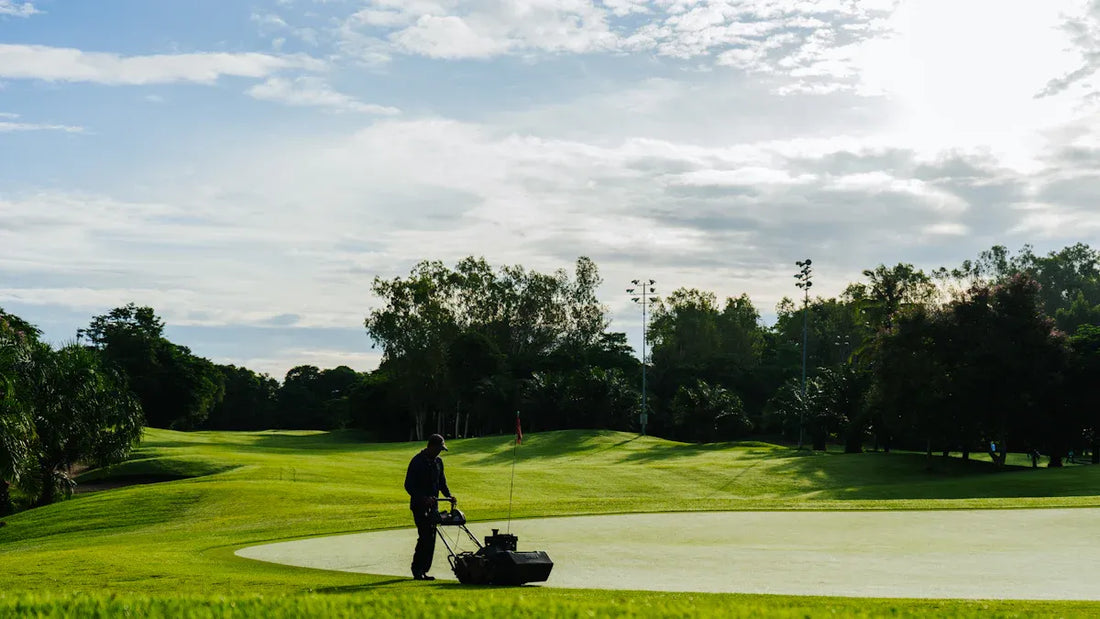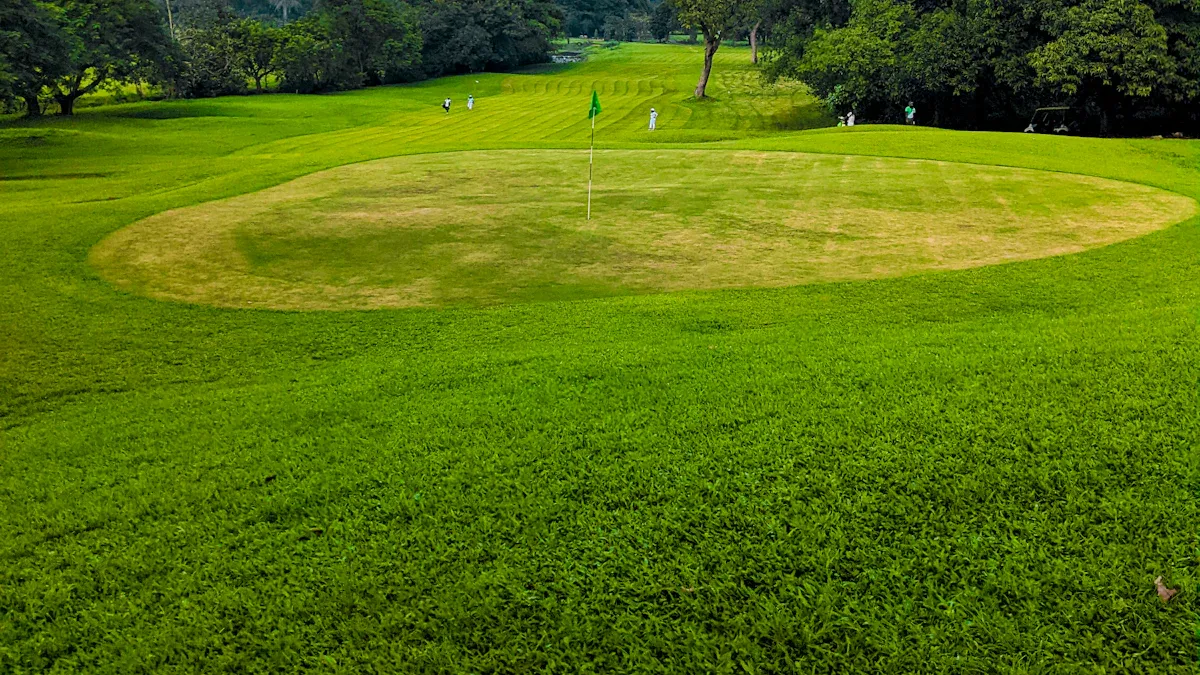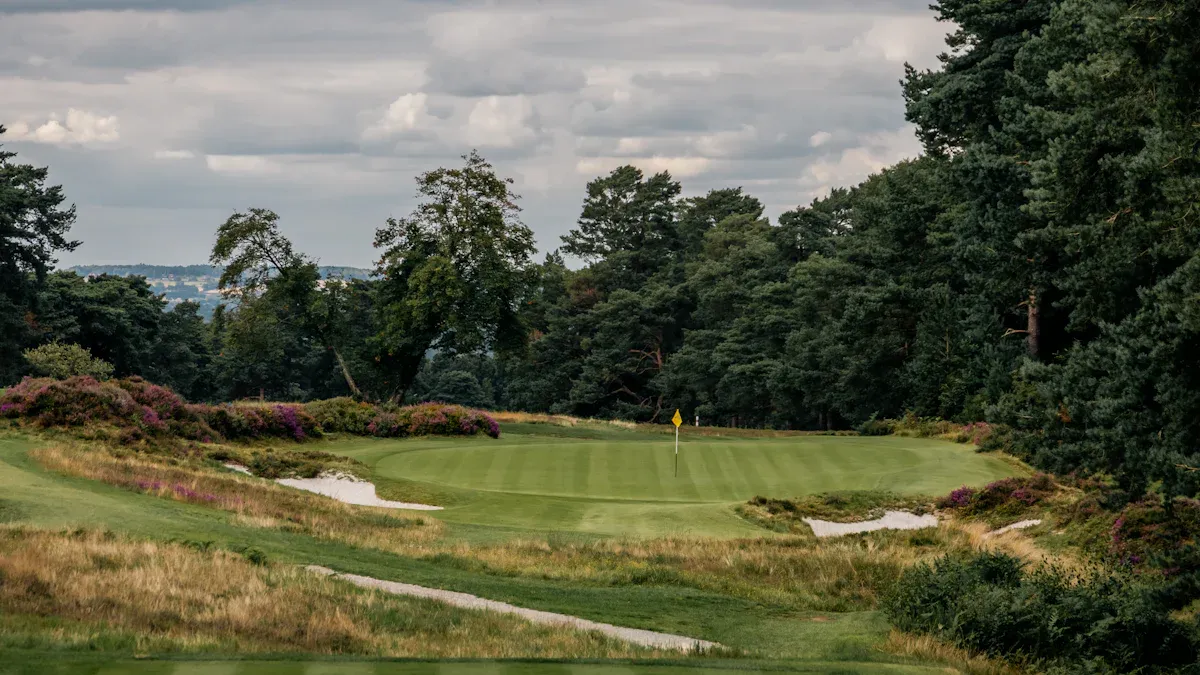
Golf Integrated Pest Management Guide for 2025
Share
Golf courses in 2025 are increasingly adopting Integrated Pest Management (IPM), a science-based approach that combines multiple strategies to manage pests effectively while prioritizing environmental and human health. This shift toward IPM has become vital due to rising environmental concerns and the demand for sustainable practices in golf course maintenance.
IPM on golf courses minimizes the use of conventional pesticides by integrating various control methods, which helps reduce costs, conserve energy, and lower risks to both health and the environment.
The advantages of IPM go beyond sustainability. It improves turf health through methods like salinity management and the use of pest-resistant plants. Furthermore, it aids in cost control by decreasing dependence on costly chemical treatments. With over 90% of golf facilities already implementing cultural practices, the adoption of IPM highlights the golf industry's growing dedication to sustainable and integrated pest management solutions.
Key Takeaways
Teego AI Golf Tee Time Bot
The only 24/7 automated tee time booking system that directly integrates with GolfNow, guaranteeing zero missed bookings.
Get A Quote Now- Integrated Pest Management (IPM) uses many ways to control pests safely.
- Preventing pests begins by choosing strong grass and caring for it well.
- Checking for pests often helps find problems early and plan solutions.
- Using natural pest controls lowers the need for chemicals and saves money.
- IPM keeps grass healthy and follows new environmental rules.
Overview of Golf Integrated Pest Principles
Definition and Goals of IPM
Integrated Pest Management (IPM) is a strategic approach that combines multiple methods to manage pests effectively while minimizing environmental and health risks. On golf courses, IPM focuses on maintaining healthy turfgrass by reducing pest populations through sustainable practices. The primary goal is to create a balanced ecosystem where pests are controlled without over-reliance on chemical treatments. By adopting IPM, you can enhance turf quality, reduce costs, and promote environmental stewardship.
Key Components of IPM
Prevention
Prevention is the cornerstone of IPM. You can reduce pest problems by selecting pest-resistant grass varieties and maintaining healthy turf through proper irrigation, aeration, and fertilization. Enhancing habitats for natural pest predators, such as birds and beneficial insects, also plays a vital role. Modifying the golf course environment to discourage pest infestations ensures long-term success.
Monitoring
Monitoring involves regularly scouting the golf course to identify pest populations and assess their impact. This step helps you determine whether pest levels exceed acceptable thresholds. Keeping detailed records of pest activity and environmental conditions allows you to predict outbreaks and make informed decisions. Monitoring also helps you document historical data, which is essential for refining your IPM strategies over time.
Control
Control methods in IPM include cultural, biological, and chemical approaches. Cultural practices, such as mowing at the correct height, strengthen turfgrass and make it less susceptible to pests. Biological controls, like releasing natural predators, effectively manage pest populations. Chemical controls should be used as a last resort, focusing on less toxic alternatives to minimize environmental impact. Combining these methods ensures a balanced and effective pest management strategy.
Tip: A well-rounded IPM program reduces pest management expenses, conserves energy, and lowers the risk of pesticide exposure to humans and wildlife.
|
IPM Component |
Benefit |
|---|---|
|
Pest Identification |
Essential for understanding pest life cycles and conditions that favor pest development. |
|
Monitoring |
Helps in quantifying pest populations and assessing damage to turf. |
|
Cultural Practices |
Maintains turfgrass health and resistance to diseases, reducing the need for pesticides. |
|
Biological Controls |
Utilizes natural predators to manage pest populations effectively. |
|
Chemical Controls |
Reduces conventional pesticide use when feasible, minimizing environmental impact. |
Benefits of Golf Integrated Pest Management

Environmental Benefits
Adopting Integrated Pest Management (IPM) on golf courses helps protect the environment while maintaining healthy turf ecosystems. By reducing chemical pesticide use, you minimize the risk of water contamination and harm to non-target species. IPM encourages practices like planting native grasses and creating unmowed areas, which can make up as much as 50% of a golf course. These areas require no fertilizers or pesticides, promoting biodiversity and conserving resources.
Since 2007, golf courses have increased their reliance on cultural practices by 66%. Over 90% of facilities with nine, 18, or 27+ holes already use these methods. Practices such as proper mowing, aeration, and irrigation not only reduce pest pressure but also enhance soil health. By integrating these strategies, you contribute to a more sustainable and eco-friendly golf course.
Economic Advantages
IPM offers significant cost savings for golf course management. By focusing on prevention and monitoring, you can reduce the need for expensive chemical treatments. Cultural practices, like maintaining healthy turf and using pest-resistant grass varieties, lower maintenance costs over time. These methods also reduce the frequency of pest outbreaks, saving you money on emergency interventions.
Biological controls, such as introducing natural predators, provide a cost-effective alternative to chemical pesticides. While initial investments in IPM tools and training may seem high, the long-term savings outweigh these costs. A well-implemented IPM program ensures that your golf course remains both beautiful and budget-friendly.
Compliance with Regulations
Environmental regulations are becoming stricter, especially for industries like golf course management. IPM helps you stay ahead of these changes by reducing pesticide use and adopting sustainable practices. Many regions now require golf courses to monitor and report their pesticide applications. With IPM, you can easily meet these requirements through detailed record-keeping and monitoring.
Using IPM also demonstrates your commitment to environmental stewardship. This not only helps you comply with regulations but also enhances your reputation among golfers and the community. By adopting IPM, you align your golf course with industry best practices and future-proof your operations against evolving standards.
Steps to Implement Golf Integrated Pest Management
Assessing Current Pest Management Practices
Start by evaluating your current pest management strategies. Identify the methods you already use and determine their effectiveness. Look for patterns in pest activity and assess how well your turfgrass responds to treatments. This step helps you understand what works and what needs improvement.
Create a list of the pests most commonly found on your golf course. Include details like their life cycles, preferred habitats, and the damage they cause. Use this information to pinpoint areas where pests thrive. For example, poorly drained areas may attract certain insects or diseases. By identifying these hotspots, you can focus your efforts where they are needed most.
Tip: Involve your maintenance team in this process. Their firsthand knowledge of the course can provide valuable insights into pest behavior and turf health.
Developing an IPM Plan
Once you’ve assessed your current practices, develop a comprehensive IPM plan. Start by setting clear goals, such as reducing pesticide use or improving turf resilience. Outline specific actions to achieve these goals, like introducing pest-resistant grass varieties or adjusting irrigation schedules.
Your plan should include a timeline for implementation and a budget for necessary tools or training. Consider the unique characteristics of your golf course, such as soil type, climate, and player traffic. Tailor your strategies to address these factors effectively.
Note: A well-structured IPM plan not only improves pest control but also enhances the overall health of your turfgrass.
Monitoring and Record-Keeping
Monitoring is a critical part of any IPM program. Regularly inspect your golf course for signs of pest activity. Use tools like sticky traps or soil probes to track pest populations. Record your findings in a logbook or digital system. This data helps you identify trends and predict future outbreaks.
Keep detailed records of all pest management activities, including the methods used and their outcomes. This documentation ensures compliance with regulations and provides a valuable reference for refining your strategies.
Emoji Tip: 📊 Use graphs or charts to visualize pest trends over time. This makes it easier to spot patterns and adjust your approach.
Choosing Control Methods
Cultural Methods
Cultural methods focus on maintaining healthy turfgrass to prevent pest problems. These practices strengthen the grass, making it less vulnerable to pests. For example, mowing at the correct height helps the grass grow stronger and reduces pest habitats. Proper irrigation ensures the turf receives enough water without creating conditions that attract pests. Aeration improves soil health, allowing roots to grow deeper and resist damage from insects or diseases.
You can also use pest-resistant grass varieties. These grasses naturally deter pests, reducing the need for chemical treatments. Rotating maintenance schedules, such as alternating mowing patterns, prevents pests from adapting to your practices. By adopting these methods, you create a healthier environment for your turf and reduce pest pressure.
Biological Methods
Biological methods use natural predators or organisms to control pests. These methods work by introducing beneficial insects, such as ladybugs or parasitic wasps, to target specific pests. For example, nematodes can help control soil-dwelling pests like grubs. You can also encourage birds to visit your golf course by creating habitats that attract them. Birds feed on insects, providing a natural way to manage pest populations.
Another approach involves using microbial products. These products contain bacteria or fungi that attack pests without harming the turf. Biological methods align with sustainable practices and reduce the environmental impact of pest management.
Chemical Methods
Chemical methods should serve as a last resort in your pest management plan. When necessary, choose products with low toxicity to minimize risks to humans and wildlife. Apply chemicals only to targeted areas to avoid unnecessary exposure. Always follow label instructions to ensure safe and effective use.
Integrated approaches, such as combining chemical treatments with cultural and biological methods, provide the best results. This strategy reduces the frequency of chemical applications and promotes long-term turf health.
Tip: Rotate chemical products to prevent pests from developing resistance.
Challenges and Solutions in Golf Integrated Pest Management
Common Challenges
Pest Resistance
Pest resistance poses a significant challenge in implementing effective pest management strategies. Over time, pests adapt to chemical treatments, making them less effective. This resistance forces you to use higher doses or switch to alternative products, increasing costs and environmental risks. Regular use of the same pesticide accelerates this process, leaving fewer options for control. Identifying pests and understanding their life cycles are critical to addressing this issue. Choosing adaptable grass species and cultivars can also reduce vulnerability to resistant pests.
Cost Constraints
Integrated Pest Management (IPM) requires substantial time, labor, and financial resources. Initial investments in tools, training, and monitoring systems may seem overwhelming. For example, scouting for pests and maintaining detailed records demand additional staff hours. While these efforts improve long-term outcomes, the upfront costs can strain budgets. Balancing these expenses with the need for sustainable practices remains a common hurdle for many golf courses.
Practical Solutions and Tips
Staff Training
Educating your team is essential for overcoming IPM challenges. Train staff to identify pests at all life stages and document their findings. This knowledge helps them make informed decisions and implement control measures effectively. Regular workshops and certifications ensure your team stays updated on the latest IPM techniques. A well-trained team reduces errors and improves the overall efficiency of your pest management program.
Leveraging Technology
Technology offers innovative solutions to streamline IPM practices. Use digital tools to monitor pest populations and environmental conditions. For instance, sensors can track soil moisture levels, helping you optimize irrigation and prevent pest outbreaks. Data-driven platforms allow you to analyze trends and predict future infestations. By integrating technology into your IPM plan, you save time and resources while improving accuracy.
Tip: Combine cultural practices like proper mowing, irrigation, and fertilization with technology to create a robust pest management strategy.
Future Trends in Golf Integrated Pest Management

Technological Innovations
Precision Pest Management Tools
Technology is revolutionizing how you manage pests on golf courses. Precision pest management tools, such as drones and GPS-guided equipment, allow you to target specific areas with pinpoint accuracy. These tools help you apply treatments only where needed, reducing waste and minimizing environmental impact. For example, drones equipped with sensors can detect pest hotspots by analyzing turf health. This data enables you to act quickly and efficiently, saving time and resources.
Robotic mowers and automated irrigation systems also contribute to pest management. By maintaining consistent turf conditions, these tools reduce the likelihood of pest infestations. Precision tools not only improve pest control but also enhance the overall health of your golf course.
Data-Driven Decision Making
Data plays a crucial role in modern pest management. Advanced software and analytics platforms help you track pest populations, weather patterns, and soil conditions. By analyzing this data, you can predict pest outbreaks and plan your actions accordingly. For instance, weather data can indicate when certain pests are most active, allowing you to prepare in advance.
Digital record-keeping simplifies compliance with regulations and helps you refine your strategies over time. With data-driven decision-making, you can optimize your Golf Integrated Pest management program for better results.
Evolving Regulations and Standards
Stricter Environmental Policies
Environmental policies are becoming more stringent. Governments and regulatory bodies now demand reduced pesticide use and greater transparency in pest management practices. Adopting sustainable methods, such as biological controls and cultural practices, helps you meet these requirements. Staying informed about policy changes ensures your golf course remains compliant and environmentally responsible.
Industry Best Practices
The golf industry is setting new standards for pest management. Organizations promote practices that prioritize sustainability and turf health. By following these best practices, you align your course with industry leaders. This not only improves your reputation but also attracts environmentally conscious golfers. Embracing these trends ensures your golf course stays competitive and future-ready.
Adopting Golf Integrated Pest strategies is essential for maintaining healthy and sustainable golf courses in 2025. These methods not only protect the environment but also reduce costs and ensure compliance with evolving regulations. By implementing IPM, you create a balanced ecosystem that supports turf health and minimizes pest-related challenges.
Explore available resources and consult with industry experts to develop a tailored IPM plan for your course. Taking these steps ensures long-term success and positions your golf course as a leader in sustainable practices.
FAQ
What is the first step in starting an IPM program for a golf course?
Begin by assessing your current pest management practices. Identify the pests on your course and evaluate the effectiveness of your existing methods. This helps you understand what works and where improvements are needed. Involve your team to gather valuable insights about pest behavior and turf health.
How often should you monitor pest activity on a golf course?
You should monitor pest activity regularly, ideally weekly or bi-weekly. Frequent inspections help you detect early signs of infestations. Use tools like sticky traps or soil probes to track pest populations. Consistent monitoring ensures you can act quickly and prevent major outbreaks.
Are chemical treatments always necessary in IPM?
No, chemical treatments should be your last resort. Focus on cultural and biological methods first. If chemicals are needed, choose low-toxicity options and apply them only to targeted areas. This approach minimizes environmental impact and reduces the risk of pests developing resistance.
How can technology improve IPM practices?
Technology streamlines IPM by providing tools like sensors, drones, and data platforms. Sensors monitor soil moisture and weather conditions, while drones detect pest hotspots. Data platforms analyze trends, helping you predict outbreaks. These tools save time and improve decision-making.
What are the benefits of using pest-resistant grass varieties?
Pest-resistant grass varieties naturally deter pests, reducing the need for chemical treatments. These grasses improve turf resilience and lower maintenance costs. They also contribute to a healthier golf course ecosystem by minimizing pest pressure and promoting sustainable practices.
Tip: Consult with turfgrass experts to select the best pest-resistant varieties for your course.
